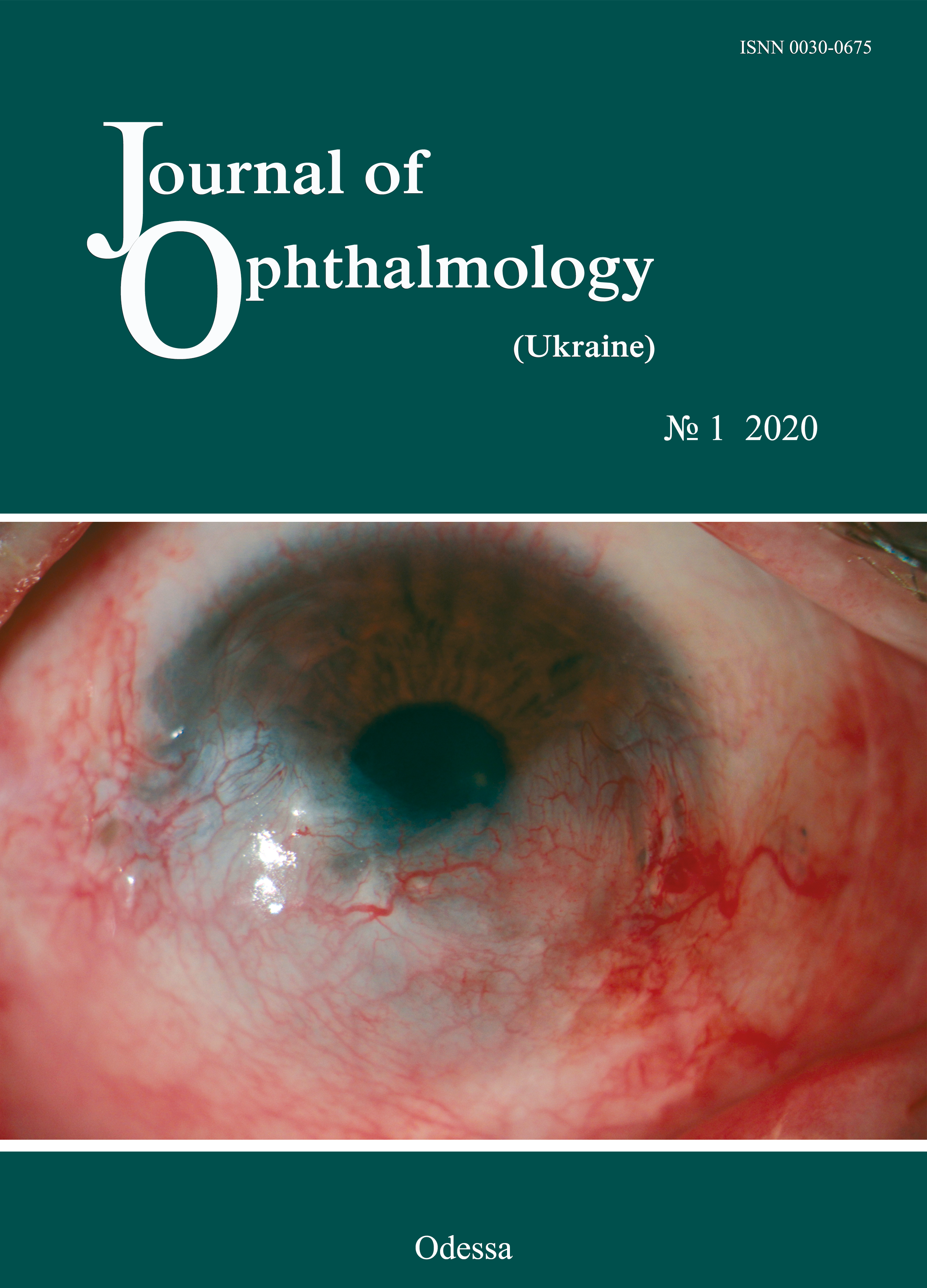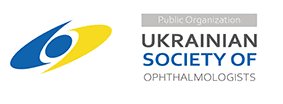Types of character accentuation in patients with recurrent herpetic keratitis
DOI:
https://doi.org/10.31288/oftalmolzh202011421Keywords:
ophthalmic herpes, accentuation of characterAbstract
Herpetic infection is the most common cause of inflammatory disease in the cornea in European countries and complicated forms of herpetic infection are the most frequent indication for corneal transplantation. Factors which control the balance between acute and latent phases in recurrent herpetic infection are not sufficiently clear. At present, psychoemotional maladjustment is also considered to be a potential co-factor for developing the infectious process.
Purpose. To study psychological features in individuals with recurrent herpetic keratitis (HK).
Material and Methods. The study involved 27 patients with recurrent stromal herpetic keratitis, aged from 23 to 50. K. Leonhard–H. Shmishek's questionnaire was used to study psychological features in the individuals with HK; the data obtained were exacted during the diagnostic interview and based on patients’ self-evaluation reports. The questionnaire diagnoses 10 types of accentuation: hyperthymic, stuck, emotive, anxious (fearful) type, pedantic, cyclothymic, disthymic, excitable, demonstrative, and exalted. Total scores of 8-12 points are within the normal range; those exceeding 8-12 points are indicative of accentuation.
Results. More frequently we revealed accentuations as follows: emotive (92.5%), stuck (81%), hyperthymic (62.9%), demonstrative and pedantic (по 59,2%), cyclothymic (56%). Exalted accentuation with a high degree of expression was noted in 44.4% of the patients. 81.5% of the patients with recurrent HK had a combination of two and more accentuations, among which the emotive accentuation was dominant.
Conclusion. Combinations of two or more types of character accentuation were found in 81.4% of the patients with recurrent HK and emotive accentuation was a dominant type of accentuated character (92.5%). Of a prevailing value in the psychological structure of the studied persons are accentuations which general characteristics are high lability of emotional reactions, their depth and duration, impressibility, vulnerability, empathy, and susceptibility. The study performed is not exhaustive; it is important to study also a role of the disease in developing maladaptive forms of psychological response.
References
1.Novikov AI, Redkin IuV, Dolgikh TI. [Opportunistic infections: epidemiological and immunological aspects and a quality of life]. Ginekologiia. 2004;6(4);3-7. In Russian.
2.Brumm G, Schnell S. Psychosomatische Grundversorgun ginder Augenheilkunde. Ophthalmologe. 2016;113:120-5.https://doi.org/10.1007/s00347-015-0182-8
3.Korostiy VI. [the mechanisms of psychological protection, alexithymia, and aggression in young people with psychosomatic diseases: the pathogenetic role and approaches to psychotherapy]. Med.psikhologiia. 2011;3:19-22. In Russian.
4.Pezeshkian N. [Psychosomatics and psychotherapy: translated from German]. M.: Meditsina; 1996. 464p. In Russian.
5.Gupalovskaya VA, Ocheretnaya EA. [The features an internal picture of the disease in patients with acquired diseases of vision]. Medychno Psikhologiia. 2013;3:20-4. In Ukrainian.
6.Emmerich G. Psychosomatik inder Augenheilkunde. Ophthalmologe. 2016;113:100-1. In German.https://doi.org/10.1007/s00347-015-0205-5
7.Flammer J, Pache M, Resink T. Vasospasm, its role in the pathogenesis of diseases with particular reference to the eye. Prog Retin Eye Res. 2001;20:319-49.https://doi.org/10.1016/S1350-9462(00)00028-8
8.Emmerich GM. Psychosomatic symptoms in somatic diseases - open-angle glaucoma for example. KlinMonblAugenheilkd. 2010;227;638-45.
9.Bertelmann T, Strempel I. Ent spannungsmethodenbeim Glaukom. Stellenwert von autogenem Training, Hypnose und Musikmedizin. Ophthalmologe. 2016;113:102-10. In German.https://doi.org/10.1007/s00347-015-0139-y
10.Nepp J. Psychosomatische Aspekte beim trockenen Auge. Ophthalmologe. 2016;113:111-9.https://doi.org/10.1007/s00347-015-0187-3
11.Paulsen AJ, Cruickshanks KJ, Fischer ME, Huang GH, Klein BE, Klein R, Dalton DS. Dry eye in the beaver dam off spring study: prevalence, risk factors, and health-related quality of life. Am J Ophthalmol. 2014;157(4):799-806.https://doi.org/10.1016/j.ajo.2013.12.023
12.Strempel I. Endokrine Orbitopathie Einsichtbarpsychophysisches Leid. Ophthalmologe. 2016;113:126-30. In German.https://doi.org/10.1007/s00347-015-0212-6
13.Carrim Z, Ahmed T, Taguri A. The relationship between stress and acute anterioruveitis. Acta Ophthalmol Scand. 2006:84(6):795-8.https://doi.org/10.1111/j.1600-0420.2006.00752.x
14.Maca SM, Schiesser AW, Sobala A, Gruber K, Pakesch G, Prause C, Barisani-Asenbauer T. Distress, depression and coping in HLA-B27-associated anterior uveitis with focus on gender differences. Br J Ophthalmol. 2011;95:5:699-704.https://doi.org/10.1136/bjo.2009.174839
15.Kot OA, Zlobina VI. [A contemporary view of etiology, pathogenesis, and treatment of accommodation spasm (literature review)]. Tavricheskii medico-biologicheskii vestnik. 2011;14/2(56):276-81. In Russian.
16.Ulyanova NA, Aymedov KV, Krivonogova OV. [Information Stress as a Factor of Influence for Psycho-Emotional State in Patients with Myopia]. Visnyk problem biologii i medytsyny. 2014;3:212-6. In Ukrainian.
17.Ulyanova N, Aymedov K, Kryvonogova O, Venger L. [Psychocorrection of maladaptive individual psychological characteristics in patients with myopia]. Oftalmologija. Vostochnaja Evropa. 2014;4:21-30. In Russian.
18.Luriia RA. [Internal picture of the diseases and iatrogenic illnesses]. M.Meditsina. 1977. 111p. In Russian.
19.Biziuk AP. [Pathopsychology: short course in the context of general and clinical psychology: workbook. Edited by Shchipitsyna LM]. SPb.:Rech;2010. 416p. In Russian.
20.Vitenko IS. [Midical psychology: textbook]. K.:Zdorovya;2007.208p. In Ukrainian.
21.Shimomura Y. Battle with herpes for 37 years. Nippon Ganka Gakkai Zasshi. 2015; Mar 119(3):145-66; discussion 167.
22.Kasparov AA. [Ophthalmic herpes]. M.:Meditsina;1994.222p. In Russian.
23.Zaitsev AV. [New approaches to treatment of cornea ulcer based on the modified micro diathermocoagulation]. Dissertation for Cand. Sc. (Med). Moscow;2014. 170p. In Russian.
24.Chida Y, Mao X. Does psychosocial stress predict symptomatic herpes simplex virus recurrence? A meta-analytic investigation on prospective studies. Brain Behav Immun. 2009 Oct 23(7):917-25. https://doi.org/10.1016/j.bbi.2009.04.009
25.Gaidamaka TB, Chaura AG, Khramenko NI. [Peculiarities of the condition of the vegetative nervous system and phychoemotional status in patients with herpetic keratitis]. Oftalmol Zh. 2009;1-2:70-2. In Ukrainian.
26.Khramenko NI, Ponomarchuk VS, Gajdamaka TB, Drozhzhina GI. [Peculiarities of the condition of the vegetative nervous system and its influence on the eye regional hemodynamics in patients with various character of recurrent herpetic keratitis course]. Ophthalmol Zh. 2013;6:5-11. In Ukrainian.
27.Raigorodskii DIa. [Practical psychodiagnosis]. [Techniques and tests]. M.:Bakhrakh-M; 2011. 672p. In Russian.
Downloads
Published
How to Cite
Issue
Section
License
Copyright (c) 2025 Н. И. Храменко, Ю. П. Фоля, Т. Б. Гайдамака, Г. И. Дрожжина

This work is licensed under a Creative Commons Attribution 4.0 International License.
This work is licensed under a Creative Commons Attribution 4.0 International (CC BY 4.0) that allows users to read, download, copy, distribute, print, search, or link to the full texts of the articles, or use them for any other lawful purpose, without asking prior permission from the publisher or the author as long as they cite the source.
COPYRIGHT NOTICE
Authors who publish in this journal agree to the following terms:
- Authors hold copyright immediately after publication of their works and retain publishing rights without any restrictions.
- The copyright commencement date complies the publication date of the issue, where the article is included in.
DEPOSIT POLICY
- Authors are permitted and encouraged to post their work online (e.g., in institutional repositories or on their website) during the editorial process, as it can lead to productive exchanges, as well as earlier and greater citation of published work.
- Authors are able to enter into separate, additional contractual arrangements for the non-exclusive distribution of the journal's published version of the work with an acknowledgement of its initial publication in this journal.
- Post-print (post-refereeing manuscript version) and publisher's PDF-version self-archiving is allowed.
- Archiving the pre-print (pre-refereeing manuscript version) not allowed.












